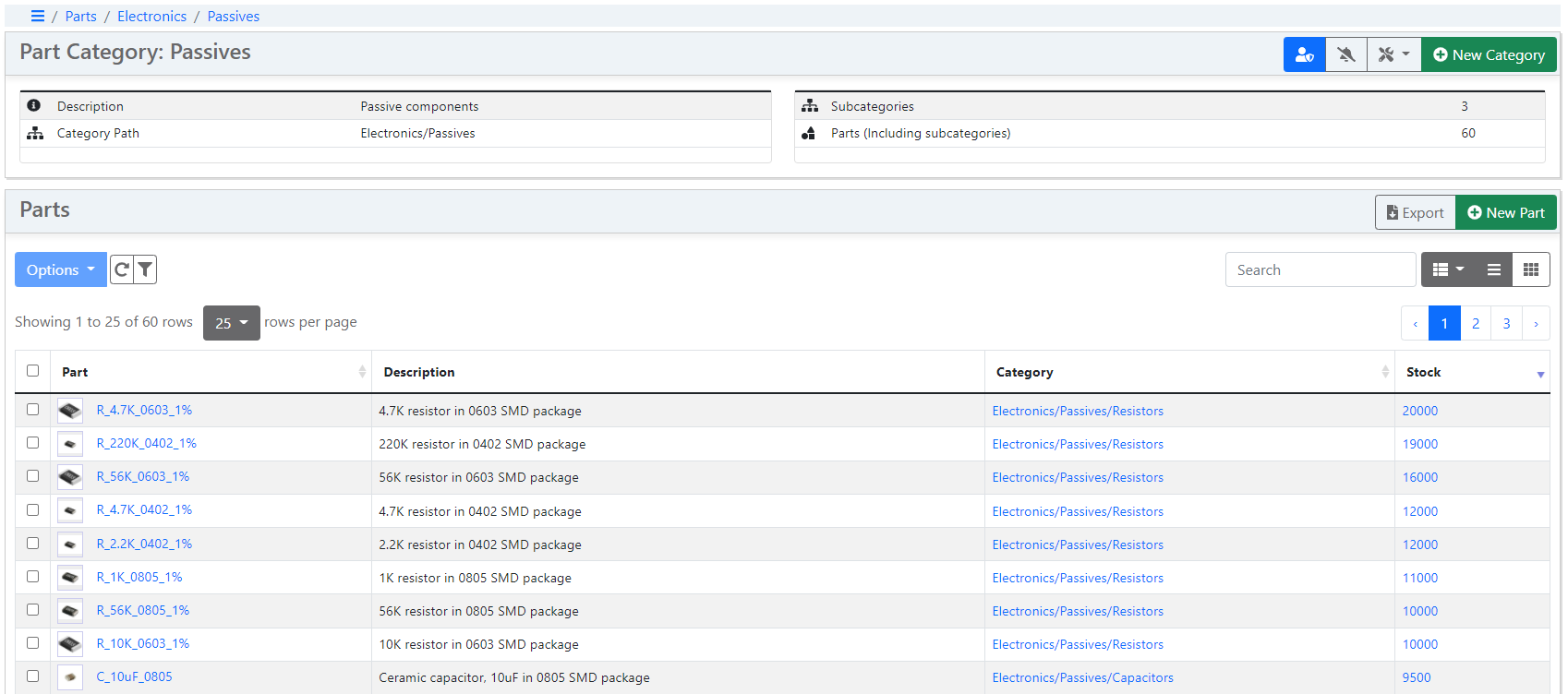Parts
Part¶
The Part is the core element of the InvenTree ecosystem. A Part object is the archetype of any stock item in your inventory. Parts are arranged in hierarchical categories which are used to organise and filter parts by function.
Part Category¶
Part categories are very flexible and can be easily arranged to match a particular user requirement. Each part category displays a list of all parts under that given category. This means that any part belonging to a particular category, or belonging to a sub-category, will be displayed.
Each part category also shows a list of sub-categories which exist underneath it.


The category part list provides an overview of each part:
- Part name and description
- Part image thumbnail
- Part category
- Part stock level
The list of parts underneath a given category can be filtered by multiple user-configurable filters, which is especially useful when a large number of parts exist under a certain category.
Clicking on the part name links to the Part Detail view.
Part Attributes¶
Each Part defined in the database provides a number of different attributes which determine how that part can be used. Configuring these attributes for a given part will impact the available functions that can be perform on (or using) that part).
Virtual¶
A Virtual part is one which does not physically exist but should still be tracked in the system. This could be a process step, machine time, software license, etc.
Template¶
A Template part is one which can have variants which exist underneath it. Read further information about template parts here.
Assembly¶
If a part is designated as an Assembly it can be created (or built) from other component parts. As an example, a circuit board assembly is made using multiple electronic components, which are tracked in the system. An Assembly Part has a Bill of Materials (BOM) which lists all the required sub-components. Read further information about BOM management here.
Component¶
If a part is designated as a Component it can be used as a sub-component of an Assembly. Read further information about BOM management here
Trackable¶
Trackable parts can be assigned batch numbers or serial numbers which uniquely identify a particular stock item. Trackable parts also provide other features (and restrictions) in the InvenTree ecosystem.
Read further information about trackable parts here.
Purchaseable¶
If a part is designated as Purchaseable it can be purchased from external suppliers. Setting this flag allows parts be linked to supplier parts and procured via purchase orders.
Suppliers¶
A Supplier is an external vendor who provides goods or services.
Supplier Parts¶
Purchaseable parts can be linked to Supplier Parts. A supplier part represents an individual piece or unit that is procured from an external vendor.
Purchase Orders¶
A Purchase Order allows parts to be ordered from an external supplier.
Salable¶
If a part is designated as Salable it can be sold to external customers. Setting this flag allows parts to be added to sales orders.
Active¶
By default, all parts are Active. Marking a part as inactive means it is not available for many actions, but the part remains in the database. If a part becomes obsolete, it is recommended that it is marked as inactive, rather than deleting it from the database.
Units of Measure¶
Each type of part can define a custom "unit of measure" which is a standardized unit which is used to track quantities for a particular part. By default, the "unit of measure" for each part is blank, which means that each part is tracked in dimensionless quantities of "pieces".
Read More
Read more on how InvenTree supports physical units of measure
Physical Units¶
It is possible to track parts using physical quantity values, such as metres or litres. For example, it would make sense to track a "wire" in units of "metres":


Supplier Part Units¶
By default, units of measure for supplier parts are specified in the same unit as their base part. However, supplier part units can be changed to any unit which is compatible with the base unit.
Example: Supplier Part Units
If the base part has a unit of metres then valid units for any supplier parts would include feet, cm, inches (etc)
If an incompatible unit type is specified, an error will be displayed:


Part Images¶
Each part can have an associated image, which is used for display purposes throughout the InvenTree interface. A prominent example is on the part detail page itself:


Image Thumbnails¶
Thumbnail images are also used throughout the interface, particularly in table views, to reduce data load on the server. These thumbnail images are generated automatically when a new part image is uploaded.
Uploading Part Image¶
Web Interface¶
In the web interface, part images can be uploaded directly from the part view. Hover the mouse cursor over the Part image to reveal multiple options:


| Action | Description |
|---|---|
| Upload new image | Select an image file from your local computer to associate with the selected part |
| Select from existing images | Select an image from a list of part images which already exist in the database |
| Delete image | Remove the associated image from the selected part |
API¶
Image upload is supported via the InvenTree API, allowing images to be associated with parts programmatically. Further, this means that the Python interface also supports image upload.
Mobile App¶
The InvenTree mobile app allows part images to be directly uploaded, either from stored files or integrated camera.
Part Import¶
Parts can be imported by staff-members on the part-list-view (this feature must be enabled in the part-settings), in the part-settings or on the admin-page for parts (only accessible if you are also an admin). The first two options provide a multi-stage wizard that enables mapping fields from various spreadsheet or table-data formats while the latter requires a well-formatted file but is much more performant.